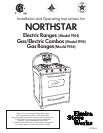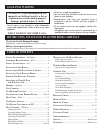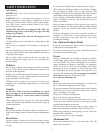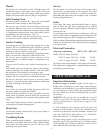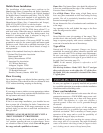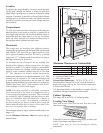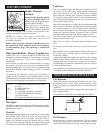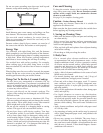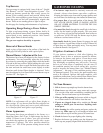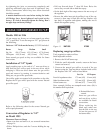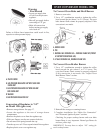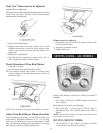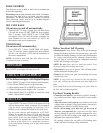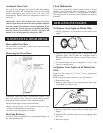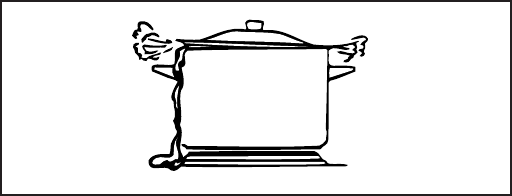
Do not use pans extending more than one inch beyond
element, except while canning. See figure 8.
Figure 8
Small diameter pans waste energy and spillage can flow
onto element. This increases chance of fire and burns.
Use non-stick coated cookware, for easier clean up.
Glass or pyroceram pans should be used only as the
manufacturer describes.
Pressure cookers, deep fat fryers, canners, etc. must be of
the correct size and have flat bottoms to work properly.
Energy Tips
Use cookware with tight-fitting lids, and flat bottoms
which completely cover the heated portion of the element.
Watch foods when bringing them to cooking temperatures
at high heat. When food reaches cooking temperature,
reduce heat to lowest setting that will keep it cooking.
Use residual heat with surface cooking. For example,
when cooking eggs in the shell, bring water to a boil,
then turn element off, and allow heat in water to complete
cooking.
When boiling water for tea or coffee, heat only the amount
needed. Do not use a wire trivet or any other kind of heat
retarding pad between the pan and the element.
Things Not To Do On A Ceramic Cooktop
• Do not leave pots unattended or elements ON for
extended periods of time. If an element is mistakenly left
on for an extended period of time the built in thermal
limiter will ensure that the heat build-up is insufficient
to cause any adverse effects.
• Do not cook directly on the ceramic cooktop. The
surface of the cooktop can be damaged, and will be more
difficult to clean.
• Do not use wire trivets mats or aluminum foil. They
offer no cooking advantages and can damage the ceramic
glass surface. Never place plastic or any other material
which might melt on any part of the cooktop.
• Do not use the cooktop as a chopping board or cutting
surface. This type of use can scratch the surface.
• Do not leave heavy spills during cooking. Turn heat
off and allow surface to cool down. Remove the spills
with a clean, damp cloth (no detergent), taking care to
avoid burning fingers. If there is detergent in the cloth,
you may leave a layer of soil-laden film on the cooktop
surface, which can result in discolouration next time the
element is switched “on”. If a detergent film builds up,
use a ceramic glass cleaner-conditioner.
Care and Cleaning
To keep the exterior chrome trim in spotless condition,
wipe with a warm soapy cloth. Do not clean hot ceramic
surface with a soapy cloth, use automotive chrome
cleaner on cool surface.
See page 28 for complete cleaning guide.
Caution - Product Damage Hazard
Before using any cleaners, ensure that it is suitable for
application on chrome trim.
Make sure that the glass ceramic surface has cooled down
before applying any cleaning materials.
1. Saving on Cleaning Time
• Make sure the bottom of pots and pans and cooking area
are clean and dry.
Select correct heat settings and use saucepans large
enough to accommodate food and liquid to eliminate
boilovers and splattering.
• Wipe up food spills and splatters from adjacent heating
areas before cooking.
• Do not drag or slide pots along the surface.
2. Daily Care
• Use a ceramic glass cleaner-conditioner, available
at supermarkets and major department stores. As the
cleaner-conditioner cleans, it leaves a protective coating
of silicone on the smooth surface, which helps prevent
scratches and abrasions in which food particles can
collect. It also helps prevent the build-up of mineral
deposits, and will make future cleaning easier.
• Apply a dab of cleaner-conditioner in the center of each
heated area to be cleaned.
• For normal cleaning start with about 1 ml (1/8 tsp) of
cleaner-conditioner, and apply more if needed.
• Clean unit with a damp clean paper towel. To remove
more stubborn spots, use a slightly dampened non-
impregnated plastic or nylon pad specially made for
non-stick utensils.
• Wipe off this application with another clean, damp paper
towel, and wipe dry.
• Use liquid cleansers to remove any discoloration,
especially in hard water areas. A non-impregnated plastic
or nylon pad specially made for non-stick utensils may
also be used with these cleaners. Do not apply excessive
pressure while rubbing. This could cause scratches over
time.
• Apply cleaner-conditioner and polish with paper towel
or a soft dry cloth.
• Any smearing or hazing on the surface may be removed
with a lightly dampened paper towel, and polished with
a soft dry cloth.
• Do not use a sponge or a dishcloth. They may leave a
film of soil-laden detergent on the heating area which
may turn brown and resemble a discolouration the next
time the area is heated. If that should happen, cleaner-
conditioner will remove it.
8



